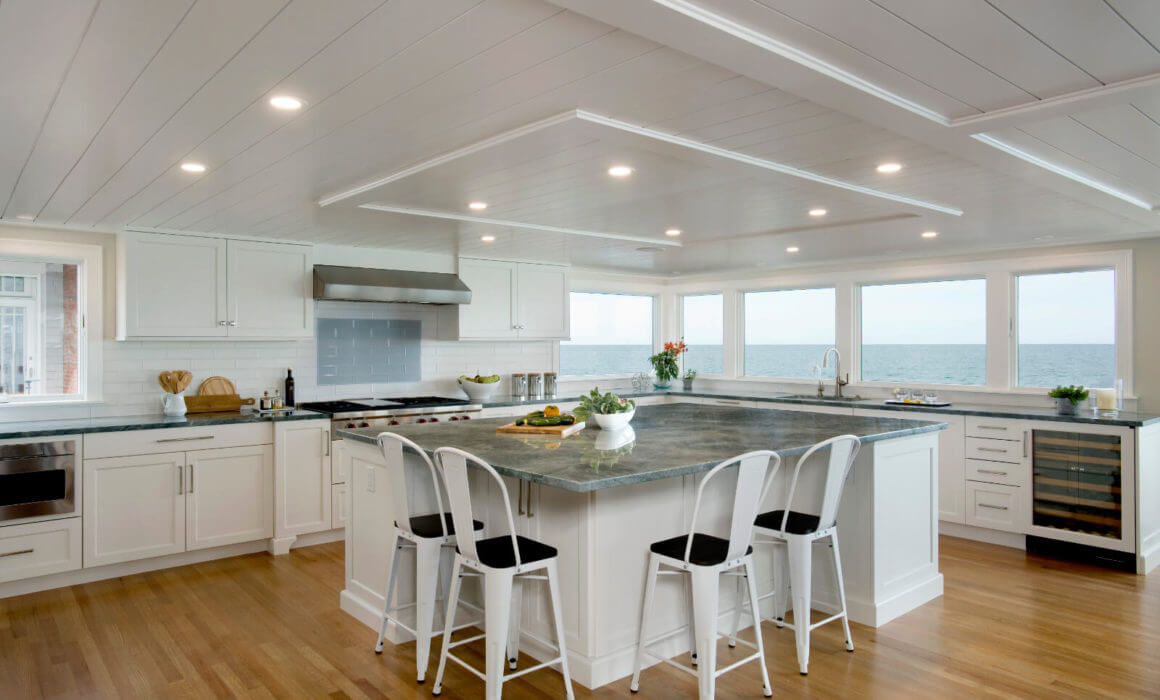Navigating Coastal Home Building and Remodeling
Successfully navigating coastal home building and remodeling unlocks the door to a unique seafront living experience. Coastal homes offer a dreamy seafront lifestyle, blending stunning views with distinctive architectural charm. This comprehensive guide delves into coastal home nuances, from architectural styles to benefits, challenges, and maintenance tips. Whether buying or building your seaside retreat, gain valuable insights here.
What You’ll Learn:
- Architectural Styles of Coastal Homes
- Benefits of Living in a Coastal Home
- Challenges and Considerations of Coastal Homes
- Maintaining a Coastal Home
- Buying or Building a Coastal Home
- South Shore Real Estate Market
- Rebuild vs. Remodel
- Beach House Renovations Before & After
Architectural Styles of Coastal Homes
Coastal homes are a blend of architectural beauty and practical design. We’ll explore styles ranging from the traditional Cape Cod to the modern Contemporary, each harmonizing with the seaside environment.
- Cape Cod Style: Cape Cod style homes, a classic of American architecture, date back to the 17th century. They’re renowned for their steep roofs and symmetrical design, crafted to withstand the harsh New England winters.
- Mediterranean Style: Inspired by coastal European regions, Mediterranean-style homes feature stucco walls, red-tiled roofs, and an emphasis on indoor-outdoor living, offering a vacation-like ambiance.
- Contemporary Coastal Style: Contemporary coastal homes, symbolizing modern seaside living, boast open floor plans, large glass windows, and eco-friendly materials, blurring the indoor-outdoor divide.
- Beach Cottage Style: Beach cottages are celebrated for their charm and simplicity. They often boast airy interiors and wooden exteriors in bright colors, along with porches or patios to savor the sea breeze.”
- Victorian Beach House Style: With their ornate details and romantic appeal, Victorian beach houses feature intricate woodwork and large porches, combining elegance and functionality.
- Coastal Shingle Style: The Shingle style, uniquely American, uses extensive wood shingles on exteriors and roofs, blending Victorian and colonial elements for a natural coastal look.
Coastal home styles are as diverse as the shorelines they adorn, showcasing a delicate balance between aesthetics and practicality. They provide valuable insights into the art of coastal living.
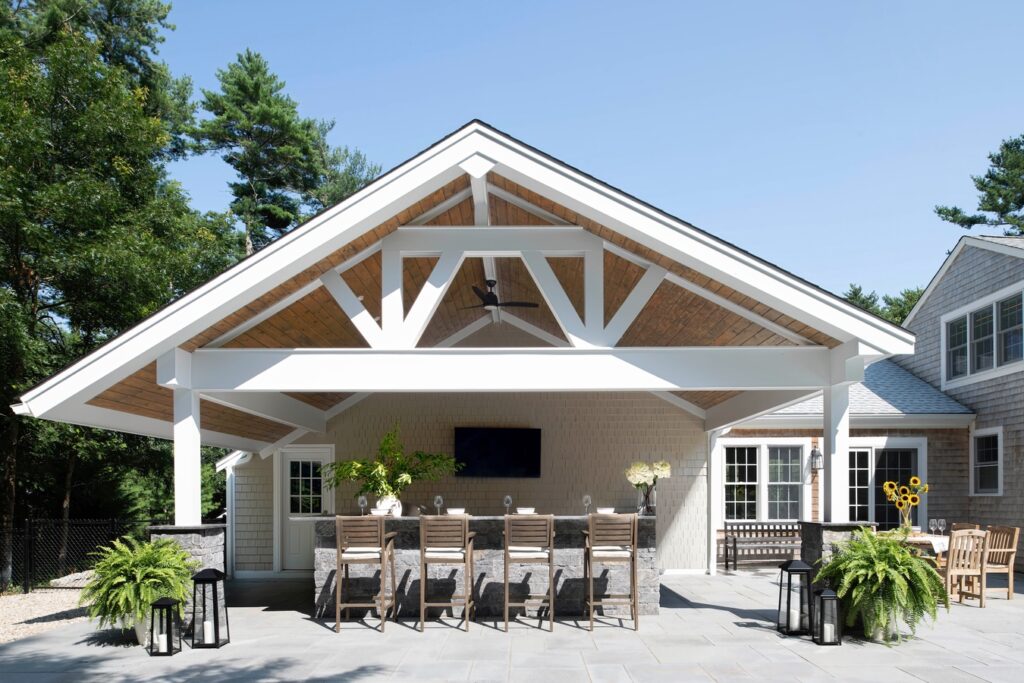
Benefits of Living in a Coastal Home
The coastal home lifestyle combines sea tranquility with home comforts, offering health benefits, recreational activities, and a strong community spirit.
- Unparalleled Scenery and Natural Beauty: Coastal homes offer stunning ocean views, beaches, and sunsets, providing a serene and ever-changing natural backdrop.
- Health Benefits: The seaside air improves respiratory health, while the sound of the waves reduces stress, and beach activities contribute to physical fitness.
- Enhanced Lifestyle and Recreation: The ocean provides a playground for swimming, surfing, and beachcombing, enhancing physical health and happiness.
- Strong Sense of Community: Coastal towns often have close-knit communities with a shared love for the sea, fostering relationships and social support.
- Connection with Nature: Living by the sea fosters an appreciation for the environment and a sustainable lifestyle.
- Therapeutic Environment: The coastal environment offers natural therapy with its calming sounds and sights.
- Investment Value: Coastal homes are often in high demand, making them a wise long-term investment.
- Infinite Inspiration: For creative minds, the ocean is a ceaseless source of inspiration.Cape
Coastal living offers a unique blend of benefits, from health and recreation to community and investment value, enriching the experience beyond a beautiful view.
Challenges and Considerations of Coastal Homes
While offering numerous benefits, coastal living presents challenges like weather conditions, erosion, and legal considerations.
- Weather Conditions and Natural Disasters: Coastal homes face hurricanes and storms, requiring robust disaster preparedness plans.
- Erosion and Coastal Changes: Erosion threatens coastal properties, requiring vigilance and erosion control measures.
- High Humidity and Salt Corrosion: The coastal climate can cause corrosion, making regular maintenance and corrosion-resistant materials essential.
- Building and Zoning Regulations: Coastal areas have strict regulations to protect shorelines and ecosystems, which homeowners must understand.
- Environmental Impact and Sustainability: Coastal living is responsible for preserving the marine ecosystem and adopting sustainable practices.
- Flood Risk and Insurance: Flooding is common in coastal areas, requiring comprehensive insurance, which can be costly.
- Access and Isolation Issues: Some coastal homes may face access challenges during extreme weather, leading to isolation.
- Impact on Lifestyle: Coastal living demands adaptation to its unique demands and lifestyle changes.
Owning a coastal home is a dream that comes with unique challenges, from weather-related issues to environmental concerns, requiring informed and prepared homeowners.
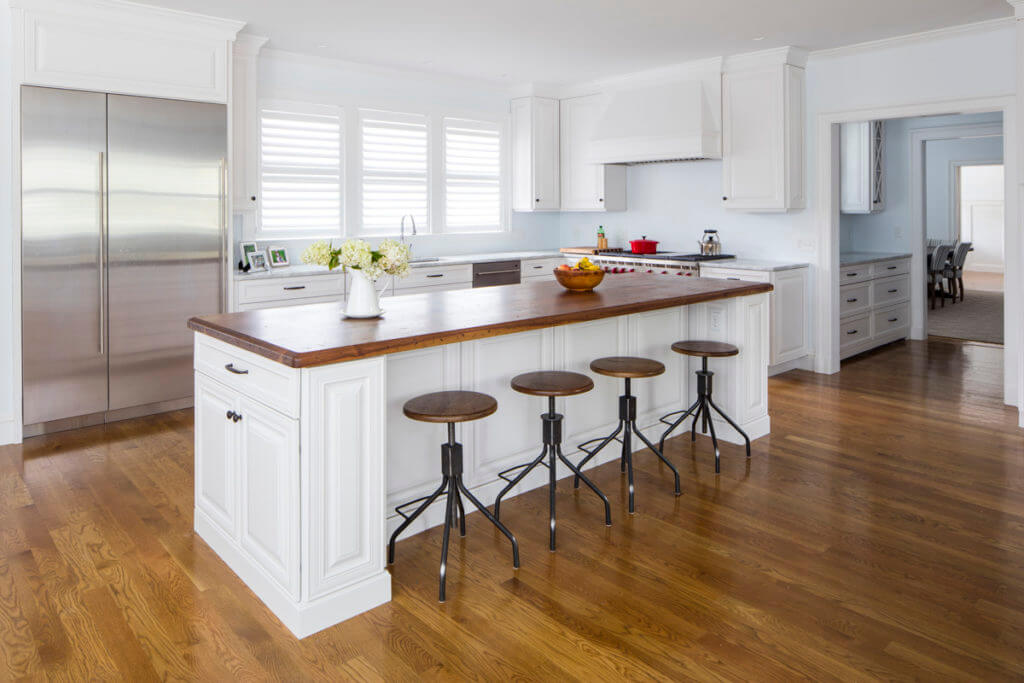
Maintaining a Coastal Home
Coastal homes require special care due to their exposure to harsh environmental elements, requiring effective maintenance and construction techniques.
- Combatting Rust and Corrosion: Use corrosion-resistant materials, regular cleaning, and protective coatings to prevent rust.
- Preventing Mold and Mildew: Ensure good ventilation, use mold-resistant materials, and conduct routine cleaning.
- Dealing with Salt Spray: Use protective window treatments and wash exteriors frequently to remove salt residue.
- Weatherproofing and Insulation: Make sure to insulate and use weather-resistant sealants to protect against the elements.
- Roof and Gutter Maintenance: Regularly inspect and clean gutters and consider durable roofing materials like metal or treated shingles.
- Foundation and Structural Integrity: In flood-prone areas, consider elevated foundations and regularly inspect for cracks or erosion.
- Landscaping and Erosion Control: Use native plants for landscaping and implement barriers to protect against erosion.
- Sustainable and Durable Building Materials: Opt for sustainable wood and composite materials for durability and lower maintenance.
Maintaining a coastal home requires understanding its challenges and employing innovative techniques to extend its life and beauty.
Buying or Building a Coastal Home
Acquiring a coastal home, whether buying or building, involves careful consideration and planning. This includes understanding market trends, choosing the right location, and addressing building considerations.
- Understanding Market Trends: Research local markets and be aware of seasonal property price and demand variations.
- Selecting the Right Location: Consider the climate, accessibility, amenities, and environmental risks in your desired area.
- Legal and Zoning Considerations: Familiarize yourself with local building codes and insurance requirements.
- Building a New Coastal Home: Choose experienced builders, sustainable materials, and design with the environment in mind.
- Financial Considerations: Be realistic about total costs, including purchase, taxes, insurance, and maintenance.
- Living in a Coastal Community: Understand the lifestyle of the coastal community to ensure it aligns with your preferences.
Buying or building a coastal home is an exciting venture that requires thorough research and careful planning for a fulfilling experience.
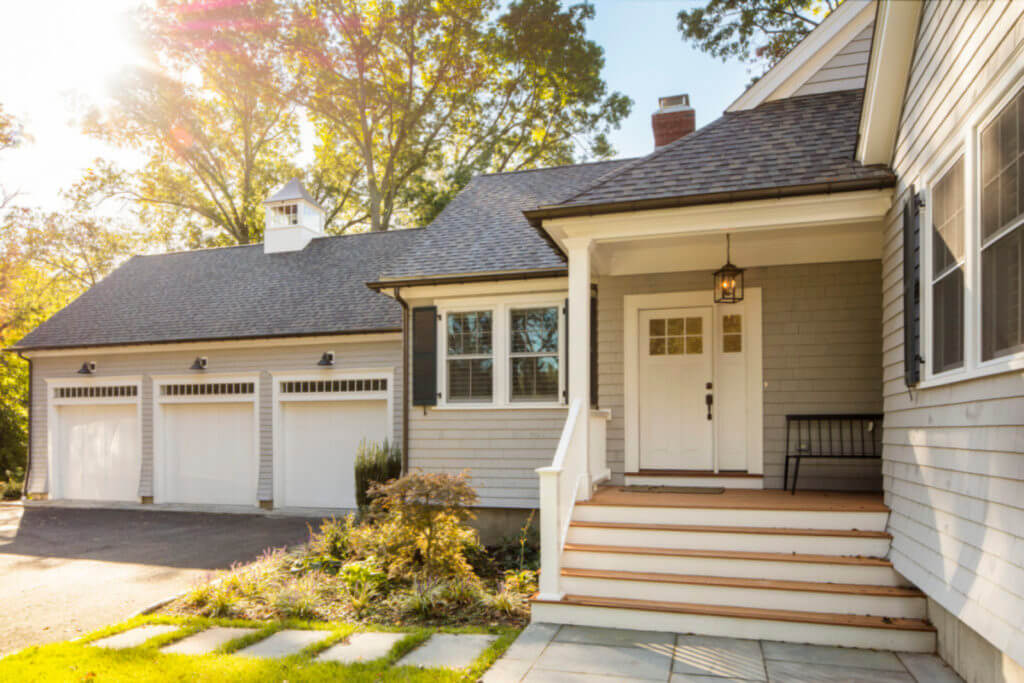
South Shore Real Estate Market
The current real estate market trends in South Shore, Massachusetts, reflect a dynamic and somewhat challenging environment:
Decrease in Listings and Sales
The Massachusetts Association of REALTORS® reported a significant decrease in new listings and closed sales in March 2023. This indicates a shift in the market, characterized by reduced availability and activity. [Source]
Median List Price and Sales Trends
As of October 31, 2023, the median list price in Massachusetts was $673,083. Interestingly, a notable 59.2% of sales were recorded above the list price, while around 30.5% of sales occurred below the list price. This suggests a competitive market with many properties selling for more than their asking price. [Source]
Rising Home Prices Amid Declining Sales:
Despite declining home sales across the state, home prices have continued to rise. The average median home price in Massachusetts was reported at $586,200, marking a 0.3% year-over-year increase. This trend indicates that the market has reached an affordability limit for many homeowners, which could impact buyer behavior and market dynamics. [Source]
Market Challenges in 2023
Experts predict 2023 to be one of the most challenging years in recent history for the real estate market in the Greater Boston area, which includes South Shore. Factors contributing to these challenges include a lack of inventory, high-interest rates, and only a moderate price reduction. High-interest rates are expected to continue putting pressure on the housing market. This is leading to a slowdown in transactions and a deceleration in the rate of price appreciation. [Source]
Market Summary
In summary, the South Shore real estate market is experiencing a period of reduced listings and sales activity. Additionally, there’s a trend of rising home prices and a competitive environment where many homes sell above their list price. High-interest rates and limited inventory add to the market’s challenges, making 2023 a particularly tough year for buyers and sellers. Potential buyers and investors should carefully consider these trends and challenges when making decisions in this market.
Remodel vs. Rebuild
Building a new coastal home offers the advantage of customizing every aspect to your preferences, from layout to materials, ensuring a modern, energy-efficient dwelling that maximizes the unique seaside environment. However, it often involves higher costs, complex regulatory challenges due to coastal regulations, and a longer timeframe compared to remodeling. On the other hand, remodeling an existing coastal home can be more cost-effective, allows for preserving historical or sentimental value, and typically faces fewer regulatory hurdles. Yet, it may involve compromises on design and layout, and hidden costs can arise due to unforeseen structural or environmental issues inherent in older properties.
Beach House Renovation Before & After
Coastal Home Transformation | South Shore, MA
White paneling and recessed lighting create a luminous and spacious atmosphere in this modern coastal kitchen. The kitchen boasts high-end stainless steel appliances, including a built-in wine cooler and professional range. Complementing the white cabinetry, the countertops are fashioned from dark, marbled granite, delivering a striking contrast. Oversized windows frame an expansive ocean view, welcoming abundant natural light into the interior. Further enhancing the room’s ambiance, the herringbone pattern wood flooring radiates warmth. Additionally, the central island serves a dual purpose: as a breakfast bar and a hub for social gatherings.
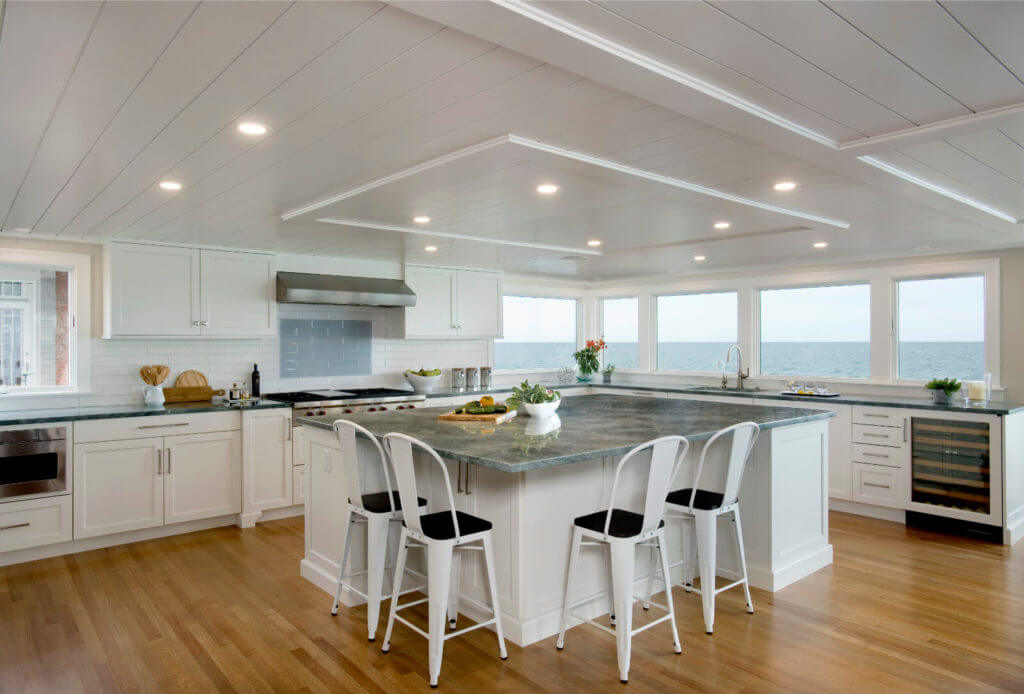
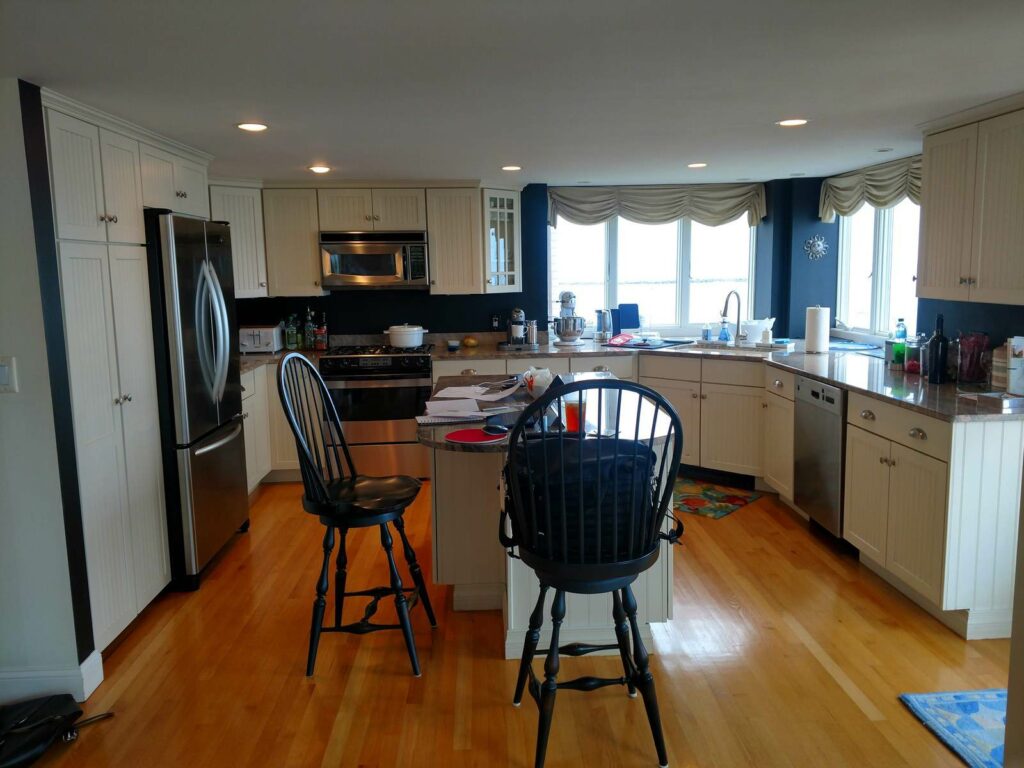
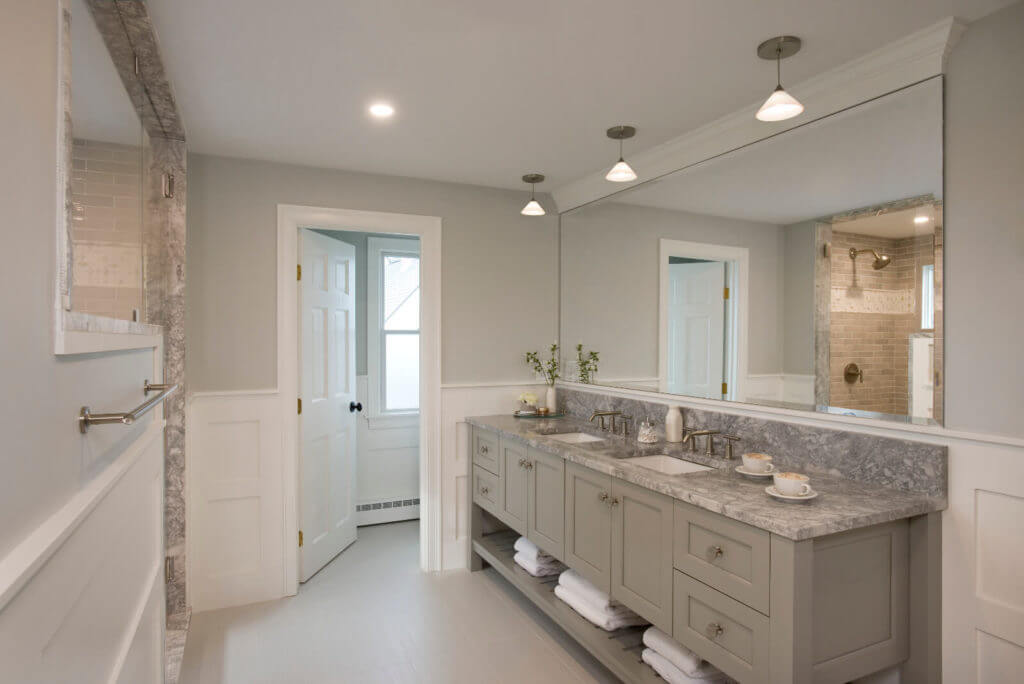
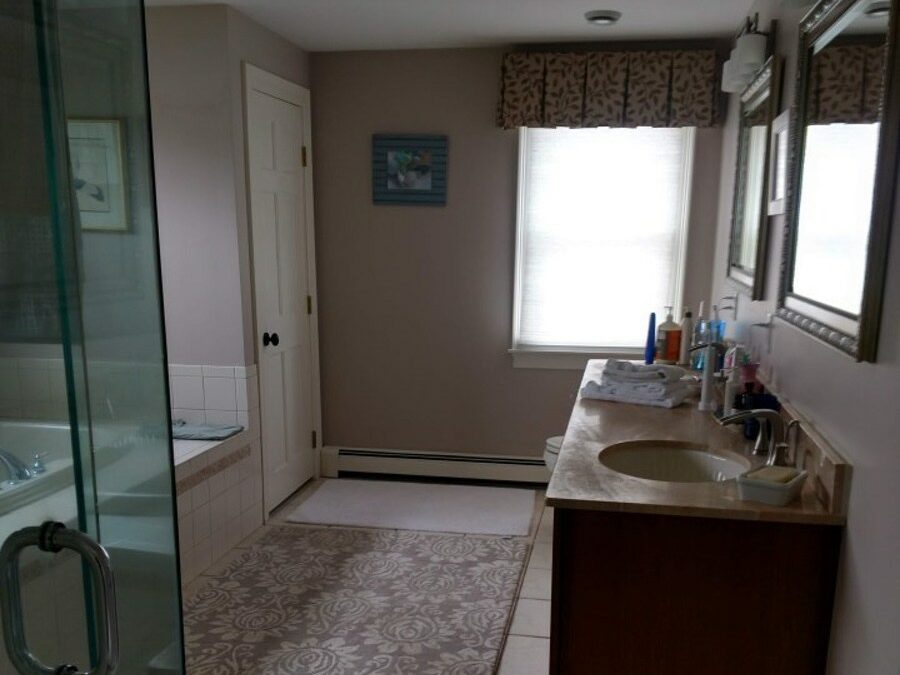
Conclusion
This coastal home building and remodeling guide highlights the beauty, challenges, and practical aspects of seaside living. From architectural styles to maintenance tips and market trends, we encourage readers to embrace the joys and responsibilities of coastal living.

